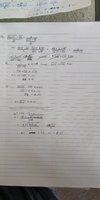The question is:
"Show that [MATH]\sqrt{N+1} - \sqrt{N} = \frac{1}{\sqrt{N+1}+\sqrt{N}}[/MATH]. Use this to explain why [MATH]\sqrt{101}[/MATH] is close to but slightly less that, 10.05.
Without using a calculator, find the roots of [MATH]x^2 +7x - 13[/MATH], giving your answers correct to 2 d.p"
The picture shows my working. My first problem is that I don't think I have given a tight enough interval which shows that the value is close to 10.05.
Secondly, the second part of the question involves the square root of 101 and I round the roots up because the root are 'close to 10.05. However, the answer in the back of the book gives the answers 1.52 and -8.52. I would probably need a smaller interval for the value of the root of 101 and that leads back to my first problem.
What do I need to do to answer this question accurately. Thanks.

"Show that [MATH]\sqrt{N+1} - \sqrt{N} = \frac{1}{\sqrt{N+1}+\sqrt{N}}[/MATH]. Use this to explain why [MATH]\sqrt{101}[/MATH] is close to but slightly less that, 10.05.
Without using a calculator, find the roots of [MATH]x^2 +7x - 13[/MATH], giving your answers correct to 2 d.p"
The picture shows my working. My first problem is that I don't think I have given a tight enough interval which shows that the value is close to 10.05.
Secondly, the second part of the question involves the square root of 101 and I round the roots up because the root are 'close to 10.05. However, the answer in the back of the book gives the answers 1.52 and -8.52. I would probably need a smaller interval for the value of the root of 101 and that leads back to my first problem.
What do I need to do to answer this question accurately. Thanks.

